PENTRE IFAN, NEVERN AND
CARNINGLI
NEVERN AND CARNINGLI
PENTRE IFAN
Pentre Ifan is a Bronze-Age
megalithic site dating from at least 4000 B.C. It is probably the
finest Welsh hilltop megalith (mega-lith = large stones). It is said
to have been originally constructed as a burial chamber, but has been
denuded of earth over several thousand years.
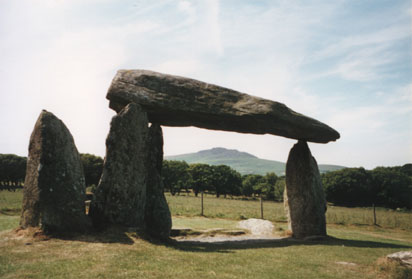 In this photograph you can see The
Hill of The Angels (Carningli) in the background. See below for more
information.
The magnificent horizontal capstone
is still in place and is estimated to weigh 40 tons. The hilltop site
overlooks Fishguard Bay and provides a beautiful setting. The belief
of the builders was that the interred soul (or souls) was closer to
the Spirit World and also closer to the Sun, whose essence was
worshipped as the giver of life, warmth and abundance. There is an
interesting passage on Pentre Ifan written in 1911 by W.Y. Evans
Wentz, author of The Tibetan book of The Dead, in his book The Fairy
Faith in Celtic countries:
"The region, the little valley on
whose side stands the Pentre Ifan cromlech, the finest in Britain, is
believed to have been a favourite place with the ancient Drulds. And
in the oak groves (Ty Canol Wood) that still exist there, tradition
says there was once a flourishing school for neophytes, and that the
cromlech instead of being a place for internments or sacrifices was
in those days completely enclosed, forming like other cromlechs a
darkened chamber in which novices when initiated were placed for a
certain number of days....the interior (of Pentre Ifan) being called
the womb or court of Ceridwen. "
Ty Canol Wood.
Fairyland...
In this photograph you can see The
Hill of The Angels (Carningli) in the background. See below for more
information.
The magnificent horizontal capstone
is still in place and is estimated to weigh 40 tons. The hilltop site
overlooks Fishguard Bay and provides a beautiful setting. The belief
of the builders was that the interred soul (or souls) was closer to
the Spirit World and also closer to the Sun, whose essence was
worshipped as the giver of life, warmth and abundance. There is an
interesting passage on Pentre Ifan written in 1911 by W.Y. Evans
Wentz, author of The Tibetan book of The Dead, in his book The Fairy
Faith in Celtic countries:
"The region, the little valley on
whose side stands the Pentre Ifan cromlech, the finest in Britain, is
believed to have been a favourite place with the ancient Drulds. And
in the oak groves (Ty Canol Wood) that still exist there, tradition
says there was once a flourishing school for neophytes, and that the
cromlech instead of being a place for internments or sacrifices was
in those days completely enclosed, forming like other cromlechs a
darkened chamber in which novices when initiated were placed for a
certain number of days....the interior (of Pentre Ifan) being called
the womb or court of Ceridwen. "
Ty Canol Wood.
Fairyland...
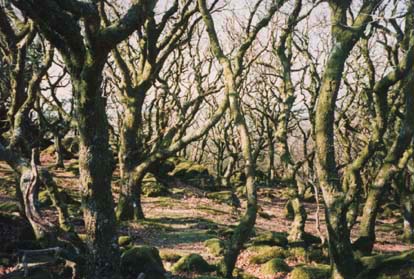 The origins of the builders of the
megalithic sites in Celtic countries is an interesting subject. Until
recently a very neatly-packaged theory, accepted by most
archaeologists and historians was that the megalith-builders were
fairly sophisticated tribes whose roots were in Eastern Mediterranean
regions or even further East. Gradually, over a period of time they
migrated Westwards through Greece, Malta, Spain, Portugal, Brittany,
and finally to The British Isles and Ireland. On their long journey
they left behind them fine examples of burial chambers, passage
-graves, dolmens and even megalithic temples (found in Greece and
Malta). So ran the theory of wandering tribesmen from the East.
Recently, however, the invention of radio-carbon dating in the 1970's
has provided an extremely accurate method of ascertaining when these
ancient sites were built and used. Two examples of many recently
dated are Pentre Ifan, and Stone Alignments at Carnac, Brittany. Both
emerge to be at least 1000 years older than their Mediterranean
counterparts, thus invalidating the 'migration' theory. "A continuous
evolutionary process of indigenous tribes" (to quote one recent
writer on the subject), seems to be the now-accepted belief. Visiting
ancient megalithic sites at quiet times and opening up to their
atmospheres will give readers their own intuitive ideas as to their
origins. Do remember that these are sacred places to be approached
with respect, and not just tourist attractions.
(Celtic Connections edition 1)
The origins of the builders of the
megalithic sites in Celtic countries is an interesting subject. Until
recently a very neatly-packaged theory, accepted by most
archaeologists and historians was that the megalith-builders were
fairly sophisticated tribes whose roots were in Eastern Mediterranean
regions or even further East. Gradually, over a period of time they
migrated Westwards through Greece, Malta, Spain, Portugal, Brittany,
and finally to The British Isles and Ireland. On their long journey
they left behind them fine examples of burial chambers, passage
-graves, dolmens and even megalithic temples (found in Greece and
Malta). So ran the theory of wandering tribesmen from the East.
Recently, however, the invention of radio-carbon dating in the 1970's
has provided an extremely accurate method of ascertaining when these
ancient sites were built and used. Two examples of many recently
dated are Pentre Ifan, and Stone Alignments at Carnac, Brittany. Both
emerge to be at least 1000 years older than their Mediterranean
counterparts, thus invalidating the 'migration' theory. "A continuous
evolutionary process of indigenous tribes" (to quote one recent
writer on the subject), seems to be the now-accepted belief. Visiting
ancient megalithic sites at quiet times and opening up to their
atmospheres will give readers their own intuitive ideas as to their
origins. Do remember that these are sacred places to be approached
with respect, and not just tourist attractions.
(Celtic Connections edition 1)
NEVERN
Our pilgrimage to some of the great
Celtic crosses now takes us to Wales, where we have accounts of two
of the most imposing of these beautiful monuments. The first is the
Great Cross at Nevern, in Pembrokeshire, and here follows a
description of the area in which the cross is found.
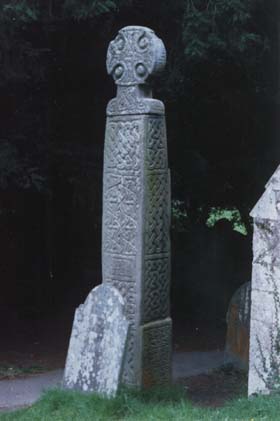 To view Celtic Crosses by
contemporary artist click
here
'Nevern, or Nanhyver as it was known
in early Celtic times must be one of the most interesting Celtic
sites in Wales. The ancient church stands in a wooded valley a few
miles from Cardigan on the noorth coast of Pembrokeshire. It is
dedicated to St Brynach, an Irish-born Celtic monk, who married the
daughter of a Breconshire chieftain and subsequently established a
number of chapels in the area, of which Nanhyver was the principal.
He died in 570 AD and was thus a contemporary of St David's. There is
a text in the British Library entitled 'The Life of St Brynach',
written not long after his death.
As you enter the church gates, the
path leads down an avenue of ancient yew trees said to date from
about the 5th century AD. At the end of the avenue, sheltered close
to the church wall stands Never Great Cross, pictured here. This is
probably the finest High Cross in Wales, and was carved about 1000
AD.
It is very well preserved and is
decorated with panels of knotwork and chevron designs. The head of
the cross is carved separately and is very graceful, with an
interlaced pattern surrounding it. The front and the reverse of the
cross have different designs, as do the two sides, and the monument
is a visual delight for those interested in Celtic carvings.
Within the church is the Maglocunus
Stone, a bilingual stone of much value to those interested in the
early Celts, as it is one of the few existing stones with
inscriptions in both Latin and Ogham script.
There is also a very early Celtic
slab cross in the church with an unusual design, probably a basic
representation of the human form. It has crudely interlaced arms,
head and 'legs'. This stone dates from the 6th century. Nevern was on
the Pilgrim's Route to St Davids, one of the most revered places of
pilgrimage in Britain. To give an idea of its sanctity in the middle
ages, two pilgrimages from Canterbury to St Davids were held as being
equivalent to one pilgrimage to the Holy city of Rome.
It is worth bearing in mind that we
are very fortunate in having such a wealth of Celtic interest to
experience at Nevern, and in the light of this we should approach the
site with reverence.
To view Celtic Crosses by
contemporary artist click
here
'Nevern, or Nanhyver as it was known
in early Celtic times must be one of the most interesting Celtic
sites in Wales. The ancient church stands in a wooded valley a few
miles from Cardigan on the noorth coast of Pembrokeshire. It is
dedicated to St Brynach, an Irish-born Celtic monk, who married the
daughter of a Breconshire chieftain and subsequently established a
number of chapels in the area, of which Nanhyver was the principal.
He died in 570 AD and was thus a contemporary of St David's. There is
a text in the British Library entitled 'The Life of St Brynach',
written not long after his death.
As you enter the church gates, the
path leads down an avenue of ancient yew trees said to date from
about the 5th century AD. At the end of the avenue, sheltered close
to the church wall stands Never Great Cross, pictured here. This is
probably the finest High Cross in Wales, and was carved about 1000
AD.
It is very well preserved and is
decorated with panels of knotwork and chevron designs. The head of
the cross is carved separately and is very graceful, with an
interlaced pattern surrounding it. The front and the reverse of the
cross have different designs, as do the two sides, and the monument
is a visual delight for those interested in Celtic carvings.
Within the church is the Maglocunus
Stone, a bilingual stone of much value to those interested in the
early Celts, as it is one of the few existing stones with
inscriptions in both Latin and Ogham script.
There is also a very early Celtic
slab cross in the church with an unusual design, probably a basic
representation of the human form. It has crudely interlaced arms,
head and 'legs'. This stone dates from the 6th century. Nevern was on
the Pilgrim's Route to St Davids, one of the most revered places of
pilgrimage in Britain. To give an idea of its sanctity in the middle
ages, two pilgrimages from Canterbury to St Davids were held as being
equivalent to one pilgrimage to the Holy city of Rome.
It is worth bearing in mind that we
are very fortunate in having such a wealth of Celtic interest to
experience at Nevern, and in the light of this we should approach the
site with reverence.
THE CAREW CROSS
We travel on to another High Cross
in Wales, which is also in Pembrokeshire. This is located today close
to the junction of the Saundersfoot to Pembroke Dock road and the
A4075 northbound route.
The Carew Cross stands approximately
13 feet high, and dates from the 9th century. There are finely
preserved panels of knotwork and key-pattering on both the east and
the west face of the cross. On the west face there is an inscription
to Maredudd ap Edwin, ruler of this region of Pembrokeshire from 1033
to 1035. This inscription was almost certainly added at a later date,
as with the fine 'Houelt' Cross at Llantwit Major which also has a
royal inscription.
The cross is close to the hauntingly
atmospheric ruins of the early medieval Carew Castle, a fascinating
yet somehow unnerving edifice with a very chequered history.
The Carew Cross may well have had a
small adjoining chapel, but today no remains are visible. To view the
east side of the cross it is necessary to stand flattened against the
hedge of a very fast main road (to avoid in turn being flattened by
passing lorries!)
This is a fine example of one of the
few free-standing High Crosses in Wales and much worthy of a visit,
bearing in mind that the fortunate medieval pilgrim would have been
making his way across open countryside, without having to encounter
the hazards of 20th century motor traffic.' (Celtic
Connections)
CARNINGLI,
THE HILL OF THE ANGELS
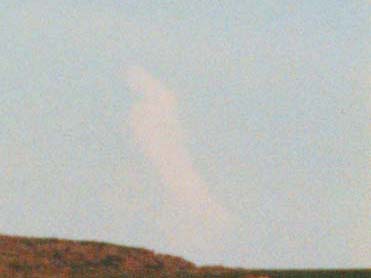 Angelic presences above Carningli
above and below!
Angelic presences above Carningli
above and below!
 If you feel like a good walk with a
certain amount of climbing then to ascend Carningli is highly
recommended. There are wonderful views on the way up and from the
top. The hill has a special atmosphere and feel about it and it is
easy to understand why it is regarded as a Sacred Place by the local
people. It is said that St Brynach used to go up the hill to meditate
and commune with angels...
View from the top with the sun
setting beyond Dinas Head.
If you feel like a good walk with a
certain amount of climbing then to ascend Carningli is highly
recommended. There are wonderful views on the way up and from the
top. The hill has a special atmosphere and feel about it and it is
easy to understand why it is regarded as a Sacred Place by the local
people. It is said that St Brynach used to go up the hill to meditate
and commune with angels...
View from the top with the sun
setting beyond Dinas Head.
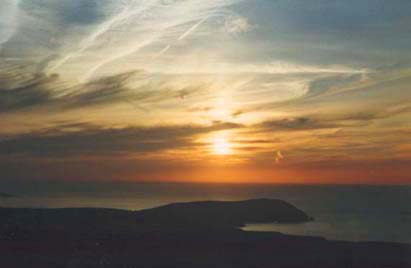 Celtic Pembrokeshire Home Page
*Gors Fawr Stone Circle and
the Presely Hills*St Davids, St Nons and St
Davids Head
*Some places of especial scenic
beauty. *Credits and Links to other
sites
* Accommodation
in Celtic Pembrokeshire
Celtic Pembrokeshire Home Page
*Gors Fawr Stone Circle and
the Presely Hills*St Davids, St Nons and St
Davids Head
*Some places of especial scenic
beauty. *Credits and Links to other
sites
* Accommodation
in Celtic Pembrokeshire

